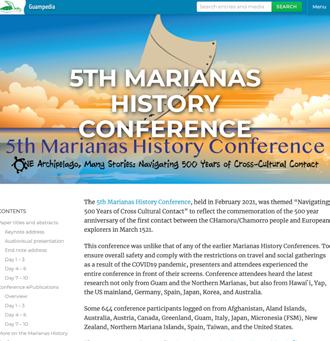
2 minute read
Modern Guam Rises Sections


April 2022 Newsletter
Guampedia Newsletter, Special Edition | Page 2 New Histories On How Guam Modernized After WWII

At the end of World War II, Guam was again placed under the control of the US Navy. Guam remained politically separated from the Northern Mariana Islands, which were placed with Japan’s other Micronesian territories of Palau, Yap, Pohnpei, Kosrae, Chuuk and the Marshall Islands under a United Nations trust to form the US Trust Territory of Pacific Islands (TTPI) to be administered by the US.
By the 1950s, with a new civilian government in place and the end of naval rule, the people of Guam began to forge a new direction towards modernity, urbanization and enjoying the opportunities of an American way of life. The term “Guamanian” reflected a new kind of identity and outlook for the people of Guam, who had survived the atrocities of war. Civilian governors were appointed by the president of the US. However, Cold War politics after World War II increased the US’ strategic and military interest in the region, and so Guam maintained large military bases on different parts of the island.
In 1952, the Territorial College of Guam was established by Governor Carlton Skinner. The college moved to its present location in Mangilao, and became the University of Guam in 1965.
In 1960, Joseph Flores was appointed the first CHamoru/ Chamorro governor of Guam. In 1962 President John F. Kennedy lifted the security clearance that had restricted entry into Guam since 1941. With this order, the island was opened up for tourism to blossom as an industry. The easing of military restrictions for entering Guam and the establishment of a local, civilian government, made the island an ideal place for people from all over the world to visit, go to school, find jobs or pursue a variety of economic interests.
In 1963, under the second CHamoru/Chamorro Governor Manuel F. L. Guerrero, the Guam Tourism Commission was established. The Guam International Airport opened in 1967, and the first flights from Japan via Pan Am arrived on-island. By the end of the 1960s and into the 1970s, Tumon Bay became the focus of a new wave of construction for numerous high-rise hotels, condominiums and entertainment venues.
Guampedia has committed to researching and writing about this exciting era of Guam history in a multi-year project. The first 16 of the new entries, along with oral histories and source documents, can be found at Modern Guam Rises from the Destruction of War, and was made possible with funding support from the Guam Preservation Trust and the Guam Economic Development Authority’s Qualifying Certificate Community Contributions program.
Guam Store in 1946/ Courtesy of the Guam Public Library Photo of Governor Manuel Guerrero/ Courtesy of the MARC
Moving Forward
Phase 3: Writers assigned to produce 15 written entries. Writers Retreat will be conducted Nov 2022. Oral History Interviews and section lesson plans to be produced and e-published.










